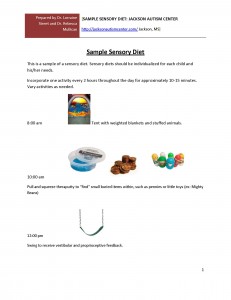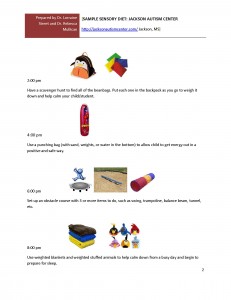As a special educator, I was constantly looking for the newest and best toys that would either teach my students better interaction skills, help us play together, or both. So I find it only fitting to share some of my favorite things so parents and professionals alike can purchase them and use them too! This is a list of ten of my favorite items for school or home.
Body Sox are one of my favorite sensory items. Your child can crawl inside, walk and move around normally, and push/pull on the fabric. They come in lots of colors and are a super fun activity on a wet, cold day.
Don’t Wake Daddy has got to be one of my favorite games to play with students who are just learning how to take turns and play a simple game. You have to be quiet and careful on the game board or you will wake daddy!
Boomwhackers are a fun, musical instrument that makes singing and circle time activities even more enjoyable. Boomwhackers are colorful, big tubes that make different noises based on their size and structure. Kids enjoy choosing them by color and this allows them to work on colors during a circle time activity.
Another activity that kids of a variety of ages and abilities enjoyed was bowling. My set talked to you as you matched colors to put the pins in place to bowl. This is a great turn taking activity because one child can set the pins up and another child can knock them down! Another bowling set I saw that looked like fun is a set that lights up- making it eye catching and enjoyable for kids. Here is that set –>
On days when it was pretty and we needed to get outside, I loved the Crayola 3D chalk art sets. This is another activity that works for many students. Some students may play with color and the 3D aspect, while other students may write spelling words or draw a spring scene.
Playdoh is always an easy activity to use with children to get their imagination going and get them to interact. Within the past few years, Playdoh came out with these new buckets of fun that come with Playdoh, cookie cutters, and other pieces that are along one theme. This is one of the themes I have- beach creations.
For students working on communicating, I used this Batmobile to get them to tell me what they wanted the car to do- make it “go!” This car is also fun because it has pieces that you can shoot out at enemies- enemies beware!
Hasbro makes a wonderful toy that even young school-aged children still love- the Explore and Grow Ball Popper. Colorful balls pop out and music plays during the game. I learned about this toy through a colleague and used this with students who were learning to communicate- make it “go” and choose a color (for kids who were ready for that). Thank you Lindsey!
Only two more to go- wow! But there are so many more items I love using! I will give you two more for now…and come back soon to find more of my favorite things!
Every year, we always learned about pirates. This is a pirate ship I always borrowed from a friend. The kids truly loved and enjoyed playing with it year after year. This is a great opportunity to encourage new vocabulary, read stories about pirates, and play other pirate related games such as hunting for treasure or pretending to ride on a pirate ship. Ahoy, mates!
One more thing for today…it would have to be the marble maze. This game is great for kids who love building and experimenting with pieces. Every time you build it, you have a completely different maze for the marbles. Older students still enjoy this game as well.
How did I afford to buy all of these new toys and games? Some of the items were purchased by the school, but not all of them. I was buying these items to keep my students engaged and excited about learning, communicating, and interacting with me! I got really good at garage sale shopping, shopping deals and clearances, and sometimes splurging on something that had to be very special!


